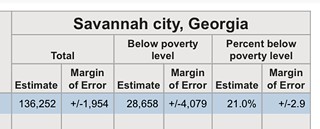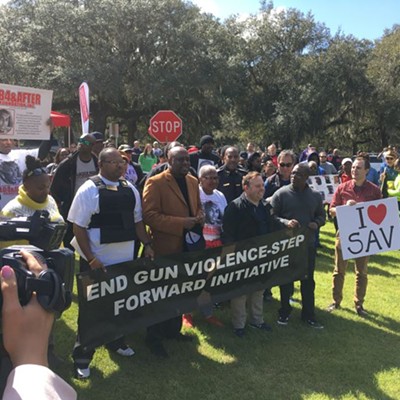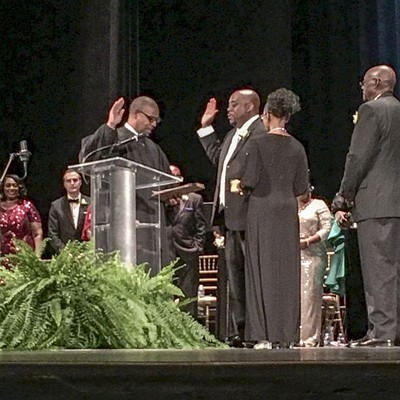WHILE MANY FOLKS focused on the non-news coming out of City Council last week that the Savannah Cultural Arts Center will be officially named... wait for it... the Savannah Cultural Arts Center, there was another tidbit that deserved much more attention.
The City of Savannah says the local poverty rate is now at a citywide 21 percent, down from 26.4 percent when the current Mayor and Council were elected and subsequently made reducing the poverty rate a key point of their strategic plan.
In the words of Alderwoman Carol Bell, the improving numbers are the product of “a real village approach,” involving the participation of not only City officials but of a wide range of “organizations and clubs, anybody in this community who’s had anything to do with focusing on poverty reduction... churches, the universities, individuals.”
The figures are based directly on U.S. Census estimates for 2017 — the most recent data available — and as estimates they do involve a small margin of error.
There has been some complaining about the source of the figures, but I’m not sure there is a better arbiter available with as big a database as the U.S. Census; if there is, I’d be eager to know about it.
The news initially was revealed at the recent City budget retreat, but didn’t get much attention at the time.
But at last week’s meeting a few City Council members practically broke their own arms patting themselves on the back.
“It’s an amazing success story for this community,” said Alderwoman Estella Shabazz.
Alderman Julian Miller announced a “celebration and rejuvenation” event to be held Dec. 19 at the Civic Center.
“We’re inviting every organization, every agency... that participated in this, to not only celebrate this but rejuvenate our efforts now that we know we can move that needle.”
Indeed, the word “celebration” or “celebratory” came up almost ten times.
“At that celebratory event we want to do a roll call” of everyone deserving credit for the reduction in poverty, said Bell.
However, Mayor Eddie DeLoach wisely counseled caution about getting that party too lit.
“As we celebrate that, let’s always remember that number is based on the fact that one in five are still in poverty. And that’s a job we need to continue to work on,” he said.
Shabazz chiefly credited the series of job fairs held by the City, the “Connecting the Dots” initiative, as well as the Mayor’s signature Summer 500 youth employment program.
I’m no sociologist, but I did a bit of digging into the U.S. Census figures used in this reckoning, specifically their American Community Survey.
Among other things, the poverty numbers show that — surprise, surprise — the rise and fall of the local numbers mirrors the national economy at large.
For example, during the depths of the great recession, Savannah’s poverty rate skyrocketed from 21.9 percent in 2009 — roughly what it is today — up to a staggering 28.9 percent poverty rate by 2011, just two years later.
The recent improvements in the local poverty rate and local median household income almost directly track the robust national improvement in the jobs market.
Median household income in Savannah for 2017 stands at $42,869, up from $38,879 in 2016, and up from $35,827 in 2015, when this Mayor and Council was elected. That’s a solid swing.
Given the upward trend in the national economy, it follows that the median income would rise in Savannah as well.
Of course, the devil, as always, is in the details.
While Savannah by some estimates has the second-lowest unemployment rate in Georgia, the sticking point has less to do with employment than with wages.
As with the country at large now, almost everyone who wants a job in Savannah can find a job.
But what do the jobs here pay?
The upward track in local median household income is certainly significant, and certainly welcome.
But the national median household income is over $60,000 a year, with a national poverty rate of 12.3 percent – nearly half Savannah’s rate.
The median household income in Georgia is over $56,000, and the state poverty rate is 14.9 percent.
Savannah, while undeniably trending better, is still hurting by comparison not only with the rest of the country, but with the rest of the state.
A deeper dive into the numbers shows more revealing nuggets of information:
• The poverty rate for children in the City of Savannah is about 35 percent.
• Almost 20 percent of Savannah households receive Food Stamps/SNAP assistance.
• Nearly one out of five adults in the City of Savannah has no health insurance at all.
• Of 57 Savannah-Chatham public schools, 38 have a majority of students on Free or Reduced Lunch. At Gadsden Elementary, every single student qualifies.
And not that there’s anything wrong with renting, but nearly six out of ten households in Savannah are rented rather than owned — compared to a national rental rate well below 40 percent.
So there is reason to applaud the recent, and likely undeniable, improvement in the citywide poverty rate. Credit should certainly be given where it’s due.
But Mayor DeLoach was correct in tamping down too much talk of a big party to congratulate ourselves. Some of the improvement can be chalked up to matters far outside the hands of any local leaders.
City officials would be wise to frame the new numbers as less of a cause for celebration, and more of a rough, but promising, beginning in addressing the particular local issues holding Savannah back.
It’s time to be hopeful, but not time for a victory lap. This race is just underway.































